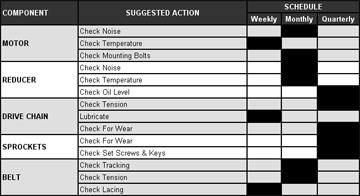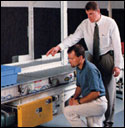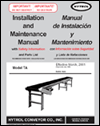 |
Planned Maintenance Checklist |
 |
 This simple checklist is a good start to performing planned maintenance on your Hytrol conveyors. The different checks should be performed on a weekly, monthly or quarterly basis as indicated by the shading of the boxes. This list is located in the back of each conveyor maintenance manual. This simple checklist is a good start to performing planned maintenance on your Hytrol conveyors. The different checks should be performed on a weekly, monthly or quarterly basis as indicated by the shading of the boxes. This list is located in the back of each conveyor maintenance manual.

|
 |
Spot Trouble Early |
 |
 The first concern is always safety. All employees should be briefed on how the equipment should operate and what to do when something does not seem right. Maintenance personnel should be trained to perform scheduled maintenance and basic emergency maintenance. The first concern is always safety. All employees should be briefed on how the equipment should operate and what to do when something does not seem right. Maintenance personnel should be trained to perform scheduled maintenance and basic emergency maintenance.
Visual Inspection Guidelines:
- Debris: Look for loose banding, strapping material, corrugated materials, paper, picking lists, tape, staples.
- Leaks: Oil spots may appear by drive components and indicate worn parts or a fluid leak. Water spots may appear from condensed air systems and are signs of a malfunction.
- Noise: Chains that are too tight tend to make a popping sound before they break. Chains that are too loose tend to make a slapping sound as the hit the chain guard. Similar equipment should have a similar noise level.
|
 |
Maintenance Manuals |
 |
 Hytrol power conveyors ship with an Installation and Maintenance Manual, which should be used as your first reference. Hytrol power conveyors ship with an Installation and Maintenance Manual, which should be used as your first reference.
Some of the topics covered are:
- Parts diagrams
- Maintenance safety precautions
- Lubrication
- Belt installation
- Belt tracking
- Tread roller installation
- Pressure adjustments for accumulation conveyors
- Drive chain alignment and tension
|
 |
How To Get Assistance |
 |
We realize many companies do not dedicate staff to maintaining conveying equipment. Even when companies do have dedicated staff, they often like knowing they have a team of experts to back them up. This is where we come in.
 We have access to: We have access to:
- Skilled troubleshooters
- Electrical technicians
- Mechanical technicians
- Welding and fabrication experts
- A full line of spare parts
|









